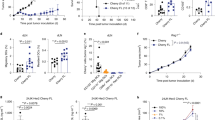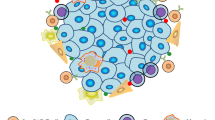Abstract
We identified a tumor-associated cytotoxic T lymphocyte (CTL) epitope derived from the widely expressed human MDM2 oncoprotein and were able to bypass self-tolerance to this tumor antigen in HLA-A*0201 (A2.1) transgenic mice and by generating A2.1-negative, allo-A2.1–restricted human T lymphocytes. A broad range of malignant, as opposed to nontransformed cells, were killed by high-avidity transgenic mouse and allogeneic human CTLs specific for the A2.1-presented MDM2 epitope. Whereas the self-A2.1–restricted human T cell repertoire gave rise only to low-avidity CTLs unable to recognize the natural MDM2 peptide, human A2.1+ T lymphocytes were turned into efficient MDM2-specific CTLs upon expression of wild-type and partially humanized high-affinity T cell antigen receptor (TCR) genes derived from the transgenic mice. These results demonstrate that TCR gene transfer can be used to circumvent self-tolerance of autologous T lymphocytes to universal tumor antigens and thus provide the basis for a TCR gene transfer–based broad-spectrum immunotherapy of malignant disease.
This is a preview of subscription content, access via your institution
Access options
Subscribe to this journal
Receive 12 print issues and online access
$209.00 per year
only $17.42 per issue
Buy this article
- Purchase on Springer Link
- Instant access to full article PDF
Prices may be subject to local taxes which are calculated during checkout






Similar content being viewed by others
References
Rosenberg, S. A. A new era for cancer immunotherapy based on the genes that encode cancer antigens. Immunity 10, 281–287 (1999).
Hanson, H. L. et al. Eradication of established tumors by CD8+ T cell adoptive immunotherapy. Immunity 13, 265–276 (2000).
Theobald, M., Biggs, J., Dittmer, D., Levine, A. J. & Sherman, L. A. Targeting p53 as a general tumor antigen. Proc. Natl. Acad. Sci. USA 92, 11993–11997 (1995).
Vonderheide, R. H., Hahn, W. C., Schultze, J. L. & Nadler, L. M. The telomerase catalytic subunit is a widely expressed tumor associated antigen recognized by cytotoxic T lymphocytes. Immunity 10, 673–679 (1999).
Minev, B. et al. Cytotoxic T cell immunity against telomerase reverse transcriptase in humans. Proc. Natl. Acad. Sci. USA 97, 4796–4801 (2000).
Theobald, M. et al. Tolerance to p53 by A2.1-restricted cytotoxic T lymphocytes. J. Exp. Med. 185, 833–841 (1997).
Roth, J., Dobbelstein, M., Freedman, D. A., Shenk, T. & Levine, A. J. Nucleo-cytoplasmatic shuttling of the hdm2 oncoprotein regulates the levels of the p53 protein via a pathway used by the human immunodeficiency virus rev protein. EMBO J. 17, 554–564 (1998).
Freedman, D. A. & Levine, A. J. Regulation of the p53 protein by the MDM2 oncoprotein—thirty-eighth G. H. A. Clowes memorial award lecture. Cancer Res. 59, 1–7 (1999).
Oliner, J. D., Kinzler, K. W., Meltzer, P. S., George, D. L. & Vogelstein, B. Amplification of a gene encoding a p53-associated protein in human sarcomas. Nature 358, 80–83 (1992).
Rammensee, H.-G., Falk, K. & Rötzschke, O. Peptides naturally presented by MHC class I molecules. Annu. Rev. Immunol. 11, 213–244 (1993).
Rock, K. L. et al. Inhibitors of the proteasome block the degradation of most cell proteins and the generation of peptides presented on MHC class I molecules. Cell 78, 761–771 (1994).
Honda, R. & Yasuda, H. Association of p19ARF with Mdm2 inhibits ubiquitin ligase activity of Mdm2 for tumor suppressor p53. EMBO J. 18, 22–27 (1999).
Craiu, A., Akopian, T., Goldberg, A. & Rock, K. L. Two distinct proteolytic processes in the generation of a major histocompatibility complex class I–presented peptide. Proc. Natl. Acad. Sci. USA 94, 10850–10855 (1997).
Stoltze, L. et al. Two new proteases in the MHC class I processing pathway. Nature Immunol. 1, 413–418 (2000).
Matzinger, P., Zamoyska, R. & Waldmann, H. Self tolerance is H-2–restricted. Nature 308, 738–741 (1984).
Rammensee, H.-G. & Bevan, M. J. Evidence from in vitro studies that tolerance to self antigens is MHC-restricted. Nature 308, 741–744 (1984).
Rötzschke, O., Falk, K., Faath, S. & Rammensee, H.-G. On the nature of peptides involved in T cell alloreactivity. J. Exp. Med. 174, 1059–1071 (1991).
Sadovnikova, E. & Stauss, H. J. Peptide-specific cytotoxic T lymphocytes restricted by nonself major histocompatibility complex class I molecules: reagents for tumor immunotherapy. Proc. Natl. Acad. Sci. USA 93, 13114–13118 (1996).
Sadovnikova, E., Jopling, L. A., Soo, K. S. & Stauss, H. J. Generation of human tumor-reactive cytotoxic T cells against peptide presented by non-self HLA class I molecules. Eur. J. Immunol. 28, 193–200 (1998).
Münz, C., Obst, R., Osen, W., Stevanovic, S. & Rammensee, H.-G. Alloreactivity as a source of high avidity peptide-specific human CTL. J. Immunol. 162, 25–34 (1999).
Stauss, H.J. Immunotherapy with CTLs restricted by nonself MHC. Immunol. Today 20, 180–183 (1999).
Dick, T.P. et al. Coordinated dual cleavages induced by the proteasome regulator PA28 lead to dominant MHC ligands. Cell 86, 253–262 (1996).
Morel, S. et al. Processing of some antigens by the standard proteasome but not by the immunoproteasome results in poor presentation by dendritic cells. Immunity 12, 107–117 (2000).
Sijts, A. J. A. M. et al. Efficient generation of a hepatitis B virus cytotoxic T lymphocyte epitope requires the structural features of immunoproteasomes. J. Exp. Med. 191, 503–514 (2000).
Stohwasser, R., Standera, S., Peters, I., Kloetzel, P.-M. & Groettrup, M. Molecular cloning of the mouse proteasome subunits MC14 and MECL-1: reciprocally regulated tissue expression of interferon-γ–modulated proteasome subunits. Eur. J. Immunol. 27, 1182–1187 (1997).
Bevan, M. J. In thymic selection, peptide diversity gives and takes away. Immunity 7, 175–178 (1997).
Steinbrink, K. et al. Interleukin-10–treated human dendritic cells induce a melanoma-antigen–specific anergy in CD8+ T cells resulting in a failure to lyse tumor cells. Blood 93, 1634–1642 (1999).
Yagi, J. & Janeway, C. A. Jr. Ligand thresholds at different stages of T cell development. Int. Immunol. 2, 83–89 (1990).
Pircher, H., Rohrer, U. H., Moskophidis, D., Zinkernagel, R. M. & Hengartner, H. Lower receptor avidity required for thymic clonal deletion than for effector T-cell function. Nature 351, 482–485 (1991).
Holler, P. D. et al. In vitro evolution of a T cell receptor with high affinity for peptide/MHC. Proc. Natl. Acad. Sci. USA 97, 5387–5392 (2000).
Foote, J. & Eisen, H. N. Breaking the affinity ceiling for antibodies and T cell receptors. Proc. Natl. Acad. Sci. USA 97, 10679–10681 (2000).
Kessels, H. W. H. G., van den Boom, M. D., Spits, H., Hooijberg, E. & Schumacher, T. N. M. Changing T cell specificity by retroviral T cell receptor display. Proc. Natl. Acad. Sci. USA 97, 14578–14583 (2000).
Clay, T. M. et al. Efficient transfer of a tumor antigen-reactive TCR to human peripheral blood lymphocytes confers anti-tumor reactivity. J. Immunol. 163, 507–513 (1999).
Willemsen, R. A. et al. Grafting primary human T lymphocytes with cancer-specific chimeric single chain and two chain TCR. Gene Ther. 7, 1369–1377 (2000).
Cooper, L. J., Kalos, M., Lewinsohn, D. A., Riddell, S. R. & Greenberg, P. D. Transfer of specificity for human immunodeficiency virus type 1 into primary human T lymphocytes by introduction of T-cell receptor genes. J. Virol. 74, 8207–8212 (2000).
Orentas, R. J., Roskopf, S. J., Nolan, G. P. & Nishimura, M. I. Retroviral transduction of a T cell receptor specific for an Epstein-Barr virus–encoded peptide. Clin. Immunol. 98, 220–228 (2001).
Kessels, H. W. H. G., Wolkers, M. C., van den Boom, M. D., van der Valk, M. A. & Schumacher, T. N. M. Immunotherapy through TCR gene transfer. Nature Immunol. 2, 957–961 (2001).
SantAngelo, D. B., Cresswell, P., Janeway, C. A. Jr. & Denzin, L. K. Maintenance of TCR clonality in T cells expressing genes for two TCR heterodimers. Proc. Natl. Acad. Sci. USA 98, 6824–6829 (2001).
Chang, H.-C. et al. A general method for facilitating heterodimeric pairing between two proteins: application to expression of α and β T-cell receptor extracellular elements. Proc. Natl. Acad. Sci. USA 91, 11408–11412 (1994).
O'Shea, E. K., Lumb, K. J. & Kim, P. S. Peptide 'velcro': design of a heterodimeric coiled coil. Curr. Biol. 3, 658–667 (1993).
Sherman, L. A., Hesse, S. V., Irwin, M. J., LaFace, D. & Peterson, P. Selecting T cell receptors with high affinity for self-MHC by decreasing the contribution of CD8. Science 258, 815–818 (1992).
Jonuleit, H. et al. Pro-inflammatory cytokines and prostaglandins induce maturation of potent immunostimulatory dendritic cells under fetal calf serum–free conditions. Eur. J. Immunol. 27, 3135–3142 (1997).
Drexler, I. et al. Modified vaccinia virus ankara for delivery of human tyrosinase as melanoma-associated antigen: induction of tyrosinase- and melanoma-specific human leukocyte antigen A*0201-restricted cytotoxic T cells in vitro and in vivo. Cancer Res. 59, 4955–4963 (1999).
Theobald, M. et al. The sequence alteration associated with a mutational hotspot in p53 protects cells from lysis by cytotoxic T lymphocytes specific for a flanking peptide epitope. J. Exp. Med. 188, 1017–1028 (1998).
Acknowledgements
We thank E. Antunes Ferreira, U. Brass, A. Heit and U. Liewer (JGU) for contributing to this study, and M. Jülch (JGU) for flow cytometric analyses. This work was supported by grants from the Deutsche Forschungsgemeinschaft (SFB 432 A3) (to M. T.), the Stiftung Rheinland-Pfalz für Innovation (to M. T.), the MAIFOR program (to J. K. and to M. T.), the Leukemia Research Fund (to H. J. S.), the Cancer Research Campaign (to H. J. S.) and the Medical Research Council (to H. J. S.).
Author information
Authors and Affiliations
Corresponding author
Rights and permissions
About this article
Cite this article
Stanislawski, T., Voss, RH., Lotz, C. et al. Circumventing tolerance to a human MDM2-derived tumor antigen by TCR gene transfer. Nat Immunol 2, 962–970 (2001). https://doi.org/10.1038/ni1001-962
Received:
Accepted:
Published:
Issue Date:
DOI: https://doi.org/10.1038/ni1001-962
This article is cited by
-
Targeting MDM2 in malignancies is a promising strategy for overcoming resistance to anticancer immunotherapy
Journal of Biomedical Science (2024)
-
T cell receptor therapeutics: immunological targeting of the intracellular cancer proteome
Nature Reviews Drug Discovery (2023)
-
T cell receptor-engineered T cells for leukemia immunotherapy
Cancer Cell International (2019)
-
Orthotopic replacement of T-cell receptor α- and β-chains with preservation of near-physiological T-cell function
Nature Biomedical Engineering (2019)
-
Principles of adoptive T cell therapy in cancer
Seminars in Immunopathology (2019)



